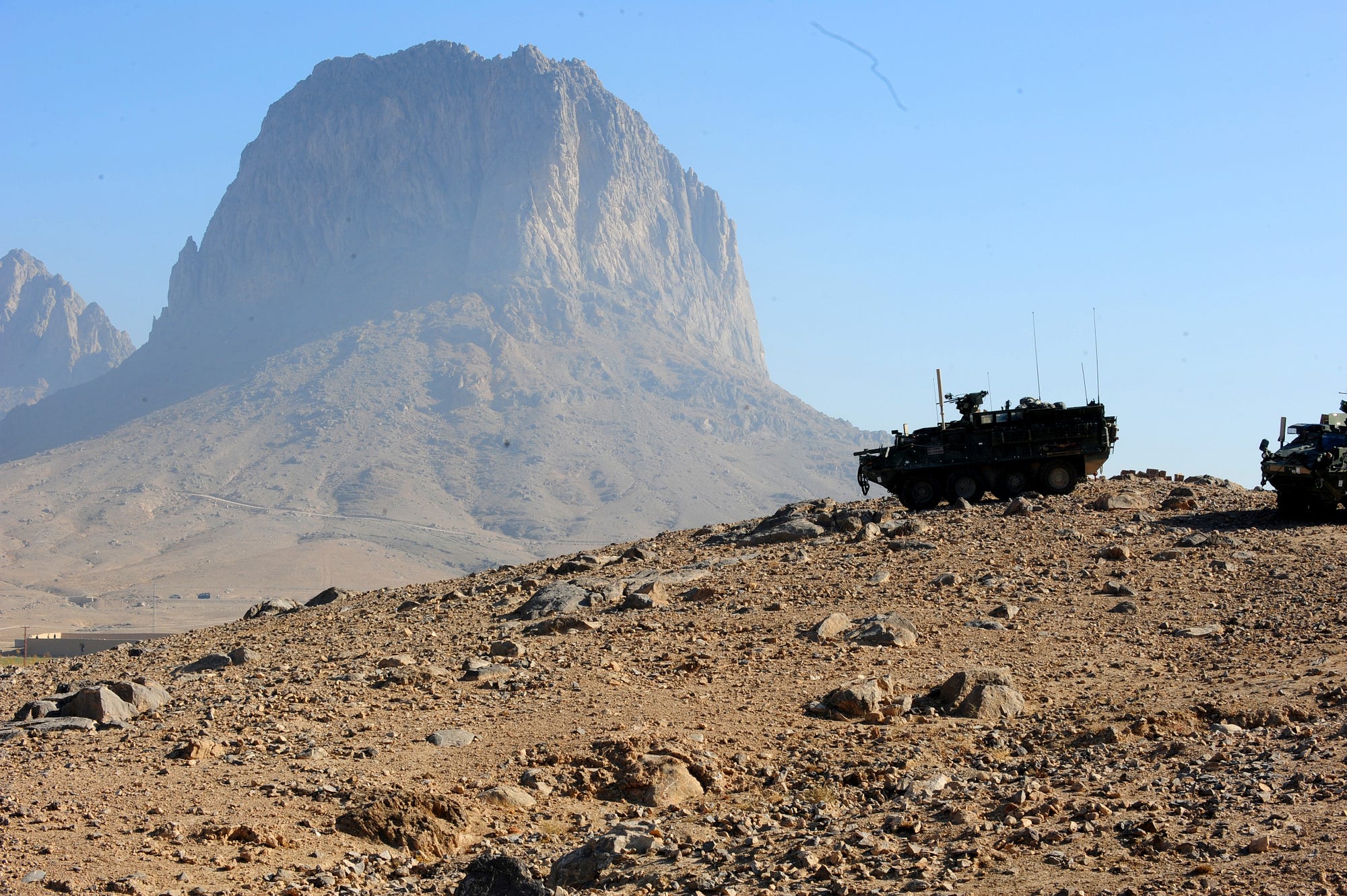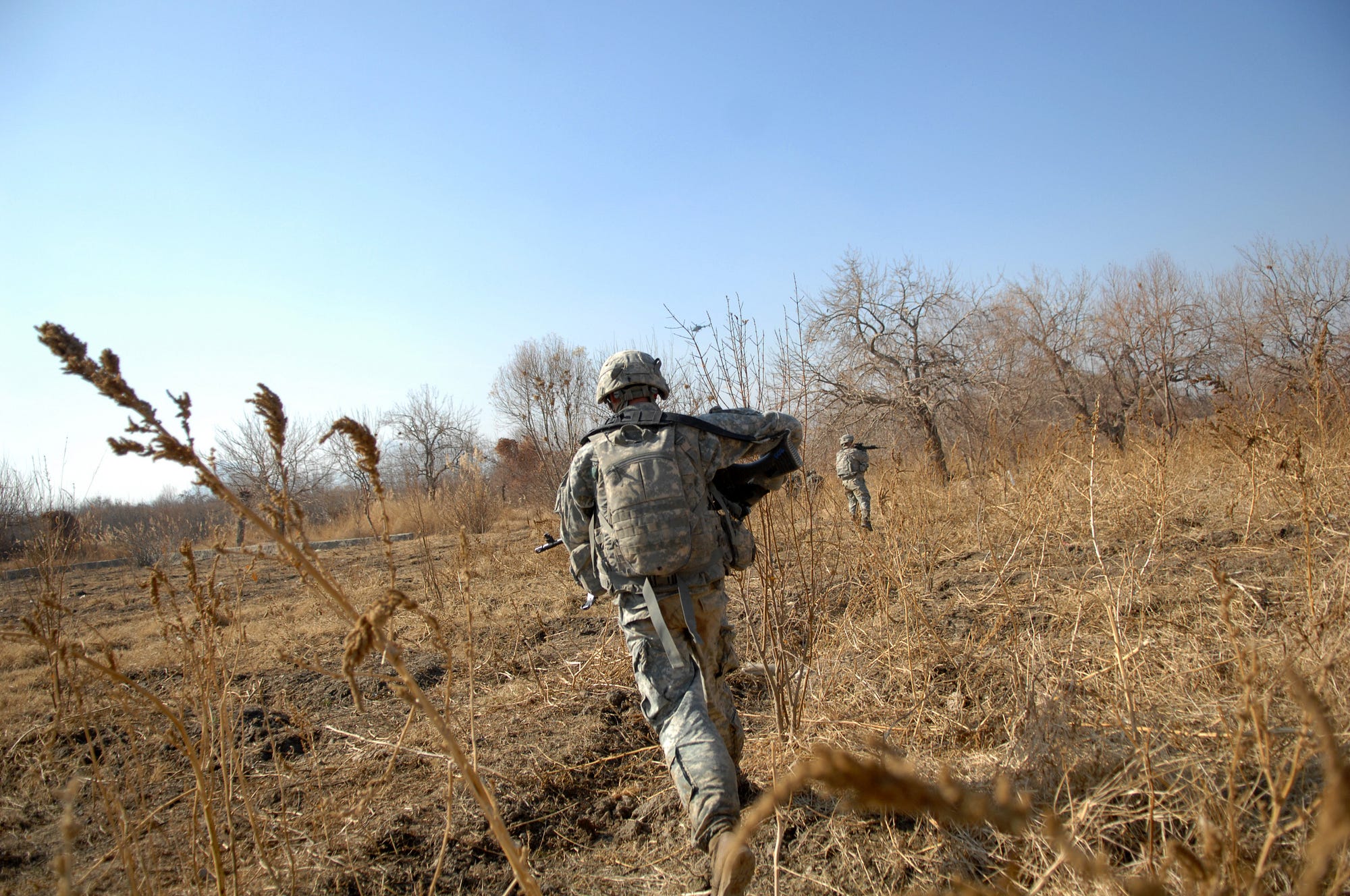Armored vehicles versus guerrillas in Afghanistan’s Arghandab Valley
The 10 Strykers charged toward the Taliban-held village. It was an armored counterattack—a response to an insurgent ambush that previously had driven off American troops under heavy fire.
The time was August 2009 in Afghanistan’s Arghandab Valley, an insurgent stronghold.
The Taliban were surprised by the sudden assault. Earlier, they had cheered and fired their weapons into the air while watching the Americans retreat. Now the soldiers in their vehicles swept forward in a V formation, a tactical move that balances flexibility with firepower.
Then one Stryker broke its axle on a rock.
To be sure, the Americans won the battle. The remaining Strykers blasted their way into village, firing high-explosive grenades from the vehicles’ automatic launchers while mounted soldiers fired their rifles from their hatches.
The arrival of air support in the form of Kiowa Warrior helicopters finally compelled the Taliban to retreat.
It was a small, little-known firefight. But the battle and others like it are at the heart of the new book Strykers in Afghanistan: 1st Battalion, 17th Infantry Regiment in Kandahar Province 2009. Kevin Hymel published the book with the Army’s Combined Arms Center at Fort Leavenworth, Kansas.
The book is available for free.
It’s a detailed account of the Army’s 1st Battalion, 17th Infantry Regiment’s time in Afghanistan. The unit took heavy losses during several months of pitched fighting with trained Taliban fighters in Afghanistan’s Arghandab Valley.
1–17 lost 22 soldiers in Afghanistan. Some soldiers criticized the battalionfor sending fellow troops unprepared into the thick brush of the Arghandab.
The book is also a look at how the Stryker combat vehicle performed in battle—in difficult terrain against a guerilla enemy.
In the 1990s, the Army envisioned the eight-wheel, medium armored trucks filling a gap between heavy tanks and light vehicles such as Humvees. The Strykers would be powerful like tanks, but without the large logistical footprint. They would be able to deploy quickly, unlike tanks. And they’d be better for the smaller-scale battles the United States could expect to fight in the future.
But the Strykers weren’t designed to fight in the Arghandab.
 At top—a 1–17 Stryker in Kandahar province, Afghanistan on Nov. 28, 2009. Above—Strykers from 1–17 in Kandahar on the same date. Army photos
At top—a 1–17 Stryker in Kandahar province, Afghanistan on Nov. 28, 2009. Above—Strykers from 1–17 in Kandahar on the same date. Army photos
1–17 moved into the Arghandab Valley in August 2009. The battalion’s 750 soldiers came to replace a Canadian advisory team that was only 1/10th the battalion’s size.
Due to the small size of the Canadian force, the fields and orchards sprawling along the Arghandab’s riverbanks were off limits. Until the Americans arrived.
The American battalion’s main mission was to beat back a resurgent Taliban. 1–17 was a small part of the 17,000-strong troop surge Pres. Barack Obama ordered early in his first term. At the same time, the troops were to help cut off Taliban reinforcements from Pakistan and boost security before the national elections.
The Arghandab, near the southern city of Kandahar, would be a serious challenge. Dominated by the Taliban, the valley was the site of heavy fighting during the Soviet-Afghan war. The region’s villages, streams and hedges amount to a maze—an advantage to the defending Taliban.
The river itself moves from north to south, bypassing the city of Kandahar, which lies to the southeast. To the west and north lies the desert.
The battalion first encountered the Taliban on Aug. 10. This occurred during a scouting mission along an unpaved road running parallel to the west bank of the river. Two Strykers drove over improvised explosive devices. One Stryker lost its wheels.
Dismounted soldiers moved into the brush. The Taliban sprang an ambush. Gunfire hit one U.S. soldier in the chest, the bullet blocked by his body armor. The Americans drove the Taliban off with mortar fire.
Eight days later, the battalion’s headquarters had stood up at Forward Operating Base Frontenac, more than 20 miles north of Kandahar and in the middle of the battalion’s area of operations. But as Hymel recounts, based on his interviews with the veterans of the battle, the troops would soon realize the Taliban in the area were well-prepared … and waiting.
The Americans also weren’t ready for this kind of fight. They had too much equipment they didn’t need, and not enough of the equipment they didneed, like minesweepers. The Canadians also left behind intelligence documents in French, which the Americans could not read.
On Aug. 18, the battalion’s Alpha Company, 2nd Platoon headed to the village of Buyana—a few miles northeast of FOB Frontenac—to investigate a suspected group of Taliban. The company had three squads and a sniper group riding in three Strykers, with a mortar Stryker and Afghan police riding in support.
According to Hymel, the soldiers took up a position on a hill to the village’s south, with the Afghans in the middle and two Strykers on the east and west sides of the hill. Platoon leader 1st Lt. Zachary Osborne interviewed the town elder, “who told him that his people had beaten the Russians with picks and shovels,” Hymel wrote.
“The meeting had only gone on for a few minutes when Osborne heard a rifle shot,” Hymel recounted. “[Osborne] looked at the elder and, through a translator, asked, ‘Is that Taliban?’”
“The elder responded, ‘Yeah, probably.’”
Osborne rushed back to the hill when the Taliban opened up with AK-47s and rocket-propelled grenades. Enemy mortar rounds splashed down on the hill, wounding two Afghans. The Afghans returned fire and quickly expended most of their ammunition.
The Strykers kept changing their positions to avoid incoming rockets. But the Taliban maneuvered faster—and closed in on three sides. Incoming rockets hit the Strykers, fortunately failing to detonate.
The Americans also couldn’t use their mortar-armed Stryker to bombard the village, due to the risk of hitting civilians. Faced with heavy resistance, the soldiers quickly boarded their Strykers and drove away and into the desert.
 Soldiers from the 1–17 run during a patrol in the Arghandab Valley on Dec. 15, 2009. Army photo
Soldiers from the 1–17 run during a patrol in the Arghandab Valley on Dec. 15, 2009. Army photo
Meanwhile, a second group of U.S. troops conducted a different operation about 24 miles to the south. This unit included Alpha Company’s 3rd Platoon and Bravo Company’s 2nd Platoon.
They headed towards the village of Babur from two directions—3rd Platoon approached from the south and 2nd Platoon from the north and west. Both dismounted their Strykers and moved by foot.
But as both platoons approached the village, they triggered improvised explosives.
Sgt. Troy Tom of 3rd Platoon—a 21-year-old from the Navajo Nation—died instantly. Another IED exploded amid 2nd Platoon, killing 20-year-old Pfc. Jonathan Yanney of Minnesota.
Taliban gunfire prevented the soldiers from reaching Tom and Yanney’s bodies.
Back near Buyana to the north, the Strykers reorganized and launched their armored counter-attack. They routed the Taliban, but their success was humbled after the soldiers learned of 2nd and 3rd Platoon’s losses.
Overnight, the battalion assigned the two lost soldiers the status of “duty station whereabouts unknown,” or DUSTWUN. At this point, the mission became about finding their remains.
The situation continued to deteriorate. The leader of 2nd Platoon, 1st Lt. Daniel Berschinski, lost his legs in an IED blast during the night. The blast threw him into a crater. Medics on board a Blackhawk helicopter that rushed to the blast site saved his life.
The next morning, the Strykers again went into action, this time in a push to secure the area where Tom and Yanney’s bodies went missing. Two platoons of Strykers and a supporting platoon of Stryker Mobile Gun Systems—packing 105-millimeter cannons—headed into the orchards.
The Strykers, Kiowa Warriors and a Predator drone with Hellfire missiles drove the Taliban out of the area. But one Stryker MGS hit an IED, disabling the vehicle except for its gun.
The blast knocked out the vehicle’s electrical power, forcing the gun crew to operate the cannon manually. They kept firing.
“There was nothing of the enemy left,” one soldier told Hymel.
With the Taliban largely driven away, the work shifted to the search. It was slow and arduous. The soldiers dismounted and waded through a smelly, brackish canal while searching for Tom.
Above, Kiowa Warrior gun runs targeted small groups of Taliban fighters who tried to get within range.
The soldiers recovered the bodies of Tom and Yanney. They returned to their Strykers—and departed.
No comments:
Post a Comment